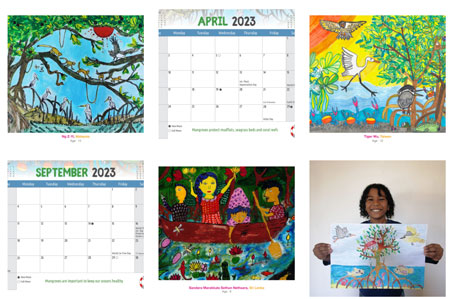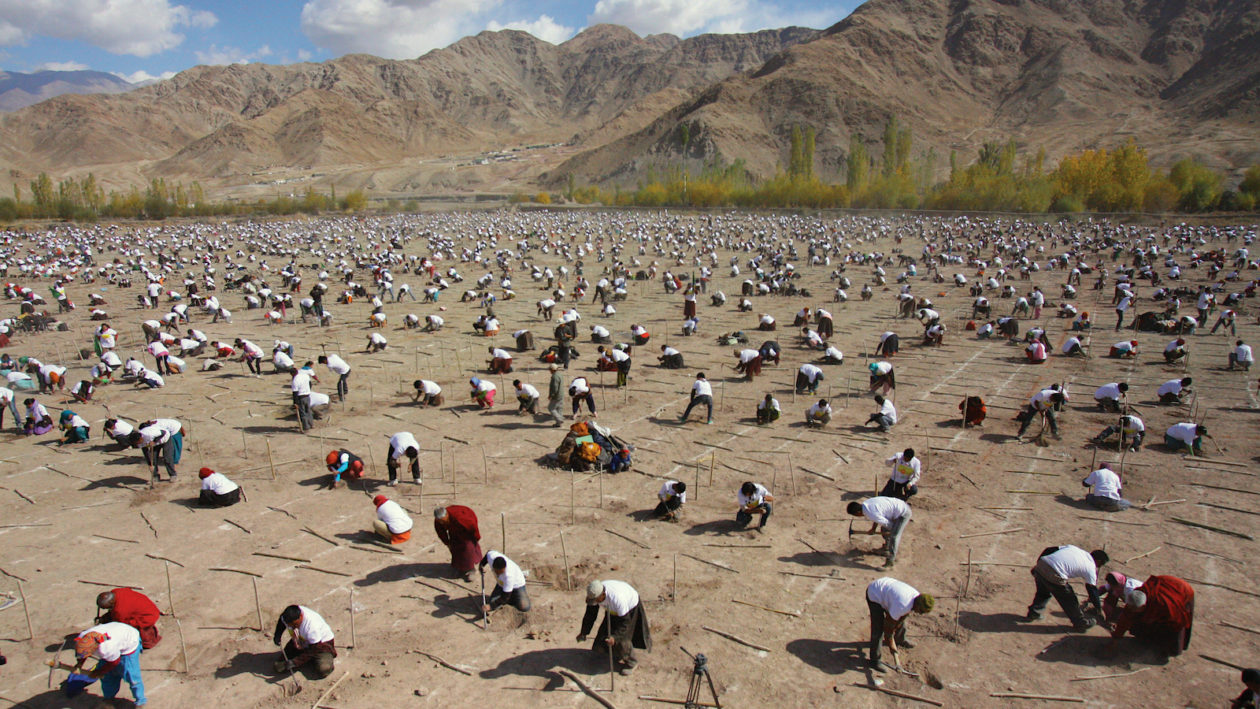FEATURED STORY
21st annual MAP’s Children’s International Art Calendars 2023 are here and ready to order!  USA – Every year, MAP conducts and international children’s art contest among students from various mangrove countries, whose artwork is then featured in our MAP Children’s Calendar. With beautiful artwork submitted by students from many countries around the world, these calendars both make a great gift, and are a helpful reminder for what we can do to assist in saving our world’s mangroves. It is an opportunity for the younger generation to learn about the vital role Mangroves play in the lives of coastal communities and marine life around the world while letting them explore their imagination and have fun when creating their art pieces. This colorful calendar has increased in popularity since its first publication in 2002. The artworks entered were incredibly stunning and expressive and have resulted in one of our most beautiful calendars to date. Many thanks to all those who took part in this year’s activities! Join us in our mission to educate, enlighten and empower the youth of today across the globe so that mangroves, and our planet, have a sustainable future!All proceeds will go towards furthering MAP’s mission of conserving, restoring, and protecting the world’s invaluable mangrove forests. Discounts available when ordering more calendars! ORDER YOURS HERE GLOBAL Phantom Forests: Why Ambitious Tree Planting Projects Are Failing

GLOBAL – t was perhaps the most spectacular failed tree planting project ever. Certainly the fastest. On March 8, 2012, teams of village volunteers in Camarines Sur province on the Filipino island of Luzon sunk over a million mangrove seedlings into coastal mud in just an hour of frenzied activity. The governor declared it a resounding success for his continuing efforts to green the province. At a hasty ceremony on dry land, an official adjudicator from Guinness World Records declared that nobody had ever planted so many trees in such a short time and handed the governor a certificate proclaiming the world record. Plenty of headlines followed. But look today at the coastline where most of the trees were planted. There is no sign of the mangroves that, after a decade of growth, should be close to maturity. An on-the-ground study published in 2020 by British mangrove restoration researcher Dominic Wodehouse, then of Bangor University in Wales, found that fewer than 2 percent of them had survived. The other 98 percent had died or were washed away. “I walked, boated, and swam through this entire site. The survivors only managed to cling on because they were sheltered behind a sandbank at the mouth of a river. Everything else disappeared,” one mangrove rehabilitation expert wrote in a letter to the Guinness inspectors this year, which he shared with Yale Environment 360 on the condition of anonymity. READ MORE AFRICA FAO plans to overhaul Gambia’s mangrove oyster industry

GAMBIA – Sustainable growth of The Gambia’s oyster sector depends on better production and responsible resource management, according to an upgrading strategy presented to 50 experts and stakeholders on 28 September. It will improve the livelihoods of the women who dominate this small-scale sector and can turn the tide on declining oyster stocks. “This plan fits perfectly in Gambia’s ambition of making its fisheries more sustainable and improve the food and nutrition security of our population,” said Omar Gibba, permanent secretary, Ministry of Fisheries, Water Resources and National Assembly Matters, at the start of a meeting where a 10-year strategy to upgrade Gambia’s oyster value chain was presented. He added, “it will benefit small-scale producers in particular, most of them women, who can feed their families and improve their livelihoods.” READ MORE Mangrove conservation in Côte d’Ivoire

COTE D’IVOIRE – In Côte d’Ivoire, the Food and Agriculture Organization of the United Nations (FAO) celebrated in Niaga, Sassandra department, the International Day for the Conservation of the Mangrove Ecosystem through the Coastal Fisheries Initiative in West Africa (IFC-WA). Dr. Yacoub Issola of the Abidjan Convention, coordinator of the mangrove component of the IPC-AO project, took this important opportunity to invite all localities with mangroves in Côte d’Ivoire to follow the successful model of the Niéga people. “Unlike other towns in Sassandra, Niaga is one of the towns that has managed to preserve its mangroves in their natural state due to their uses and customs. For this reason, we have chosen this town to host the first edition of the International Conservation Day. of the Mangrove Ecosystem to encourage and show our gratitude to the local population for their efforts to protect this unique, special and fragile ecosystem”, he said. Mr. Lamine Coulibaly, Prefect of the Gbôklè region, Prefect of the Sassandra department, invited the women of the region to contribute to the preservation of the mangroves by putting an end to the use of the mangroves for smoking fish. READ MORE ‘Our diamonds are our forests’: turning Madagascar’s degraded land green again

MADAGASCAR – In Madagascar, calls for urgent action to safeguard its rapidly disappearing native forests are growing. The fourth-largest island on Earth, it boasts one of the most diverse ecosystems, with hundreds of thousands of flora and fauna species, 85% of which are found nowhere else. Nine out of 10 of these unique species live in forests. Without the forests, they won’t survive. But Madagascar has one of the highest rates of deforestation in the world. Much of its native forest has been cleared – 45% in the past 60 years alone. The Food and Agriculture Organization (FAO) and the German Agency for International Cooperation (GIZ) have joined forces with the country to remedy this situation in the Diana and Boeny regions in the north. The Forests4 Future (F4F) project aims to restore forests and landscapes as well as improve forest governance by 2026. This project is funded by the German Federal Ministry for Economic Cooperation and Development (BMZ), implemented by GIZ and works in collaboration with the FAO-hosted Forest and Farm Facility (FFF). In the past two years, F4F has restored 285 hectares (ha) of forested landscapes, including mangroves. This is expected to reduce soil erosion, improve biodiversity and increase available water. READ MORE AMERICAS Mangrove restorers in Haiti bet on resilience amid rising violence

HAITI – Jean Wiener should be elated. The organization he leads, FoProBim, has just won a series of grants to help protect mangroves in Haiti. In the coming months, he and his team will crisscross the country, helping replant mangrove marshes, conducting environmental workshops and training sessions, and starting alternative income projects for those whose livelihoods depend on cutting mangrove trees. The grant will allow his organization, which has been based largely in the northwestern town of Cap-Haïtien, to operate on a truly national scale for the first time. So why does he look ashen-faced and glum? “I just got off the phone with my assistant in [the Haitian capital] Port-au-Prince,” he says, slumped in front of the camera for our first video call. “He’s got PTSD from all the gunshots outside his house.” The grant comes just as Haiti’s growing social unrest has hit a decade-long high, making travel around the country perilous. Since the murder of President Jovenel Moise in July 2021, lawlessness has spiraled out of control. Haiti’s mangroves also face grave danger. Statistics are hard to come by, but historical sources speak of mangrove forests once cloaking virtually all of the country’s coastline, sometimes extending inland as far as 6 kilometers (nearly 4 miles), and teaming with fish, turtles and caimans. READ MORE Mangroves keep carbon in the soil for millenia

MEXICO – On top of all the other dazzling biology, mangrove forests are massive carbon sinks. In fact, according to new research on a Mexican mangrove forest, they can keep carbon out of the atmosphere for millennia. A study published in Marine Ecology Progress Series has found that the carbon stored in peat under the mangrove forest is over 5,000 years old. “What’s special about these mangrove sites isn’t that they’re the fastest at carbon storage, but that they have kept the carbon for so long,” says co-author Emma Aronson, an associate professor in microbiology and plant pathology at the University of California, Riverside, US. “It is orders of magnitude more carbon storage than most other ecosystems in the region.” It’s well-known that mangroves, like other plant ecosystems, are good at absorbing CO2 from the atmosphere and storing it in soil, with the help of a range of different microbes. In a wet, oxygen-low environment – like under mangrove forests – the organic matter can form carbon-rich peat. But soil carbon storage is rarely permanent: over decades or centuries, the carbon is cycled back into the atmosphere. The researchers set out to examine the microbial life, as well as the carbon and nitrogen storage, of marine mangrove forests near La Paz in Mexico. READ MORE ASIA Indigenous belief systems bolster mangrove reforestation in Palawan

PHILIPPINES – In the middle of the brackish water of Malampaya Sound in the Philippines’ Palawan province, Panchito Calamare stands on an outrigger fishing boat one drizzling May morning, slowly pulling in his crab line and removing one by one the day’s haul. When he returns home, he hands over the crabs to his wife, Gloria, to weigh. Other fishermen also come to sell their catch to the couple. Within an hour, their regular buyer arrives to collect the catch, which will eventually land in restaurants and hotels across the province.The couple recognise that their bountiful catch is tied to the thick mangroves blanketing the sound’s coast. “We take care of our mangroves. We don’t cut them down, because it’s where the crabs and fishes spawn,” says Panchito, 53, from the Indigenous Cuyunon group. “That’s also why we make sure other people won’t destroy them.” Sitting in the shade of a nipa hut, 44-year-old Gloria faces a mangrove forest while weaving a fishing net. “The mangroves are really a big help to us,” she says. READ MORE Teaching the next generation of Filipinos the value of forests and the importance of sustainably managing them

PHILIPPINES – The youth is key to sustainably use and manage forests, especially in the context of a changing climate. Inculcating the value and role of forests in biodiversity, food security, climate, health and well-being should begin early on in the life of a child. FAO and the Philippines have launched a new initiative this month to teach children about the importance of managing forests sustainably to safeguard natural resources in a changing climate. Funded by Germany, and using an innovative hands-on approach, the project will develop forest education modules for children aged 9-12 to teach them about the vital relationships between forests and biodiversity, food security, climate, health and wellbeing. ”This project is all about instilling in future generations an understanding of how important forests are for all of us, and the knowledge to manage and protect them in the future,” said Sheila Wertz-Kanounnikoff, FAO Representative ad interim in the Philippines. Entitled “Forests for a sustainable future: educating children”, the project starts with an inception workshop, a teachers’ focus group discussion and school visit between 13-15 September to gather information for the design of the modules. The project comes amid growing international concern over the quality and availability of forest training and education globally, with countries rarely providing forest education at primary level. READ MORE
Like this newsletter?
 Pease consider donating to MAP to keep it going.
Giving could never be easier  *Articles in this newsletter may mention practices being used and/or show exagerated results being claimed without proof. Stories are presented here in effort to show mangrove related activity around the world and do not necessarily reflect Mangrove Action Project’s views or mangrove restoration best-practices. | NOTICE 
Mangrove Macrobenthos Managament Conference MMM6 Colombia 2023
On behalf of the Organizing Committee of the MMM6, we want to announce that MMM6 organizers are working to hold the conference in the last week of July 2023 in Cartagena de Indias. We hope to make the official launch very soon. We invite you to follow them on twitter @MeetingMmm6
ACTION ALERTS Do not sacrifice Congo’s rainforests to the oil industry! TAKE ACTION TAKE MAP SURVEY Please see the survey questionnaire we at MAP put together to discover where the shrimp industry is still having major adverse effects on mangroves and local communities.
TAKE THE SURVEY Stop the Dredging – 6.7 million cubic meters of sand from the Addu atoll basin will destroy nature, biodiversity and the natural defences and resilience of this UNESCO Biosphere Reserve. SIGN THE PETITION Keep fossil fuels out of Bangladesh for the health and wellbeing of the local communities, the beautiful regional beaches and forests, the Bangladeshi economy, and our shared climate. SIGN PETITION Stop this total madness Stop the biggest heated oil pipeline in the world — right through the heart of Africa!
CLICK HERE
Like this newsletter? Pease consider donating to MAP to keep it going. Giving could never be easier 
MAP Website en Español
haga clic aqui 13 Year old Linda Li “Mangrove Adventure” from Kid Dream Art School

WATCH NOW 
Restoring The Natural Mangrove Forest
Watch movie

Community Based Ecological Mangrove Restoration in Rufiji Delta VIEW VIDEO
Video: Mangroves for the Future
View Here WANT TO GET INVOLVED?
Follow and Join MAP!    
Like this newsletter? Pease consider donating to MAP to keep it going. Giving could never be easier 

Interested in connecting or working with MAP? Check out our opportunities here 
MANGROVE ISSUES Want to learn more about mangroves?
Our short presentation will give you a better understanding of the issues we are working to solve. WATCH PRESENTATION What is CBEMR? Download MAP’s 2 page CBEMR Information Sheet containing links to all MAP’s CBEMR resources – CLICK HERE View MAP’s uploaded Videos at
MAP Video Gallery Question Your Shrimp Consumer/Markets Campaign!
WATCH VIDEO Mangroves: Guidebook to Malaysia – Click Here SHARE MAP’S VISION
CLICK HERE to watch short introductory video. Together we can work “at the roots of the sea”. Our short documentary, Reducing the Risk of Disaster through Nature-Based Solutions : Mangroves 
NASA Study Maps the Roots of Global Mangrove Loss

Marvellous Mangroves Curriculum The Marvellous Mangroves Curriculum begins with a simple philosophy – getting future generations to not only learn about, but understand the importance of mangrove forests. VISIT 
The award-winning Marvellous Mangroves (MM) curriculum educates children on the importance of mangroves and their ecological functions, teaching them about modern challenges and mechanisms for sustainability. VIEW VIDEO Marvellous Mangroves Curriculum in Bangladesh – WATCH VIDEO
MARVELLOUS MANGROVES IN BRAZIL
En Portuges 
Marvellous Mangroves – A Curriculum-Based Teachers Guide.
Like this newsletter? Pease consider donating to MAP to keep it going. Giving could never be easier 
“Question Your Shrimp” Campaign Question Your Shrimp – is it really sustainable? Sign the Petition
Note to Our Readers: We strive to keep active links in our newsletter. However, due to circumstances beyond our control, occasionally links to stories may become broken. If you find a link to a story is not functioning, please cut and paste the headline into your browser search bar. In most cases you should be able to locate the original story.
Not yet a MAP News subscriber?
Click here to subscribe. 
*Articles in this newsletter may mention practices being used and/or show exagerated results being claimed without proof. Stories are presented here in effort to show mangrove related activity around the world and do not necessarily reflect Mangrove Action Project’s views or mangrove restoration best-practices.
|

























